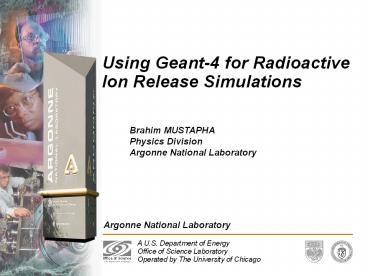Using Geant-4 for Radioactive Ion Release Simulations - PowerPoint PPT Presentation
Title:
Using Geant-4 for Radioactive Ion Release Simulations
Description:
1. Total Path Length = Flight time: tf (Maxwell distribution of velocities for given (T,M) ... Total Path Length ~ 290 m. For Li-8 at 1950 C, this ... – PowerPoint PPT presentation
Number of Views:37
Avg rating:3.0/5.0
Title: Using Geant-4 for Radioactive Ion Release Simulations
1
Using Geant-4 for Radioactive Ion Release
Simulations
Brahim MUSTAPHA Physics Division Argonne National
Laboratory
2
Outline of Presentation
Framework Motivations Production of
Radioactive Beams Description of the Release
Process Simulation of Effusion using
Geant-4 Simulation of Diffusion Example of Target
Simulation Optimizing the Target Geometry Summary
Outlook
3
Production of Radioactive Beams
Geant-4 Simulation Optimize the target geometry
for an efficient
production and transport of radio-isotopes.
4
The Release Process
The important parameter? Time from production
to release Why? Extract as many ions as
possible before they decay. How to minimize
this delay ? - Choose target material
(not always possible) - Optimize
target geometry gt Object of
this work
Why use Geant-4?
- Possibility of implementing complicated
geometries and modify them easily. - Object oriented Adding new physics processes
possible and easy. - 3. Visualization capabilities to test and
debug the geometry and the tracking.
5
Simulation of Effusion using Geant-4
Effusion A new physics process added to Geant-4
- 1. After diffusion particles (atoms or ions)
have thermal energies. - 2. A Particle is tracked inside the target until
it encounters a surface. - At the surface, a particle could be adsorbed
(sticking time) then desorbed. - A random direction obeying the Cosine Law and
pointing to the target volume - is assigned to the particle. (Cosine Law
the probability of a given direction - is proportional to the cosine of its angle
with the normal to the surface) - 5. Particles are allowed to exit only through
the ion source.
Output of the Simulation event by event
1. Total Path Length gt Flight time tf
(Maxwell
distribution of velocities for given (T,M)) 2.
Number of Collisions gt Sticking time ts
(Assuming an average sticking time per collision.)
6
Some Difficulties Partially Solved
- Geometry dont close 100, Leakage at corners and
connections. - Partially solved by reducing
thicknesses from mm to microns - Boolean Geometries didnt work well.
- Seem to work better with recent
versions of Geant-4 (5.2) - At some point, problems with defining ions.
- Not needed anymore, simulation done
for one type (alpha particles) - to obtain Path Lengths and Number of
Collisions which are valid for - any type of ion.
- At the surface, particle infiltration to the
material instead of being - re-emitted to the target volume.
- Also reduced by reducing walls
thickness.
7
Simulation of Diffusion
Cant easily be done using Geant-4
Done analytically using the solution of the
diffusion equation
For thin foils the distribution of diffusion
time is given by
is the characteristic diffusion time given by
d is the foil thickness D is the diffusion
coefficient
Diffusion time td, generated randomly according
to P(t)
? Total delay time t td tf ts
8
Example of Target Simulation RIST
Geometry Target 18 cm long 2cm
diameter 3600 25 µm discs Con.
Tube 5 cm long 8 mm
diameter Ionizer 3 cm long 3 mm
diameter
Result of the effusion simulation lt
Number of Collisions gt 2.4 million lt
Total Path Length gt 290 m For Li-8 at
1950 C, this corresponds to a lt Flight Time gt
115 ms Diffusion coefficient and average sticking
time obtained by fit to the data.
9
Best Fit to the data
Best fit D lt 10-7 cm2/s ts 0 ns l 2
cm Delay times Effusion 100 ms Diffusion gt
5 s
Conclusion Diffusion is dominant, slow
compared to Li-8 decay (0.84 s)
? Use thinner discs
10
Optimizing the Target Geometry
Shorter Ionizer
Thinner Discs
Disc Thickness d (m) 25
2.5 ltN. of Collisionsgt 1.6 106
1.6 107 ltPath Lengthgt (m)
190 190 ltEffusion timegt (s)
0.075 0.075 ltDiffusion
timegt (s) 52 0.52
Efficiency (), Li-8 (.84 s) 8.2
67
Ionizer Length l (cm) 3.5
2. 1. ltN. of Collisionsgt
2.5 106 1.6 106 1.6 106
ltPath Lengthgt (m) 290 190
120 ltEffusion timegt (s) 0.115
0.075 0.047 ltDiffusion timegt
(s) 52 52 52
Efficiency (), Li-8 (.84 s) 7.9
8.2 8.4
11
Summary and Outlook
Geant-4 used successfully to simulate the
effusion of radio-isotopes from a production
target. Will use Geant-4 for future simulations
of more complicated geometries, such those filled
with fibers or grains.































